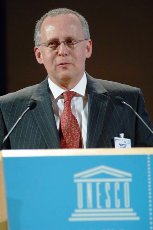
Ted Nield has a Christmas message. Sciences gain political influence when they learn how to kill people.
Geoscientist 19.1 January 2009
I should make it clear before I launch into this rant that I am not really suggesting scientific progress is sufficient reason for indulging in war. On the other hand, there is no doubt that science has often done very well out of it. Our own, for example, benefited hugely from World War 2, whose oceanographic magnetic and gravity surveying led directly to plate tectonic theory. But I fear that nowadays we are lagging way behind.
Consider the most politically influential sciences – physics, chemistry, biology. How did they get where they are? Until WW2, physics was an arcane and low budget pursuit. All that changed pretty quickly, though. Dapper émigré physicist Leo Sziliard* remembered the very moment. He was crossing the road in Russell Square, London, towards The Imperial Hotel. By the time he reached the other side of Upper Woburn Place, the idea of an explosive nuclear chain reaction was fully formed in his mind. The atom bomb had been born. No more music of the spheres, chum. Physics had become death, destroyer of worlds.
But physics was only following on the coat-tails of chemistry. Exactly 100 years ago last year (on 13 October 1908 to be precise) Fritz Haber discovered how to fix nitrogen. This discovery, made commercial by Carl Bosch in 1913, has since allowed each arable hectare on Earth to support 4.3 people today as opposed to a meagre 1.9 in 1908. But, Haber harboured other ambitions too – namely, giving Germany control over its nitrogen sources for munitions manufacture. Thus Haber successfully prolonged WW1, added considerably to the death toll of WW2, and in fact led directly to between 100 and 150 million deaths in the 20th Century. His invention also paved the way for dynamite, thus also the Nobel Foundation, and the Nobel Prizes awarded each year for peaceable pursuits. (One of which, of course, went to Haber himself in 1931. He kept quiet about munitions in his acceptance speech.)
Biology, the very science of life, has obvious potential to become an agent of the apocalypse, and as those who remember the 1970s TV Series
Survivors (now being reprised by the BBC) will recall, this science already has its name down for World War 3. So where is geology's WMD?
In Jon Amiel's delightfully preposterous sci-fi action film
The Core (2003) evil geophysical genius Dr Conrad Zimsky, played by Stanley Tucci, has been working on a secret US government-funded research programme to direct seismic waves at enemy targets. Sadly, his experiments have had the unfortunate side-effect of stopping the circulation of the outer core, thus endangering the Earth's magnetic field and providing the film's dramatic spring.
But that crime aside, perhaps Dr Zimsky had the right idea. For, when it comes to politics and influence, as President Lyndon Baines Johnson famously observed: "When you have them by the balls, their hearts and minds will follow". Put geology down for World War 4.
Now – for a more sensible suggestion about how to gain policy influence in a happier new year,
read this month's Soapbox - and the worked example in this month's feature.
*
Editor's note: The motto of online journalism is (or could be) "not wrong for long". The print version of this piece wrongly credits the first conception of a fission chain reaction to Isaac Isidor Rabi. It was actually Leo Szilard. In haste I picked the wrong Jewish-Hungarian dapper émigré physicist.
Ted Nield